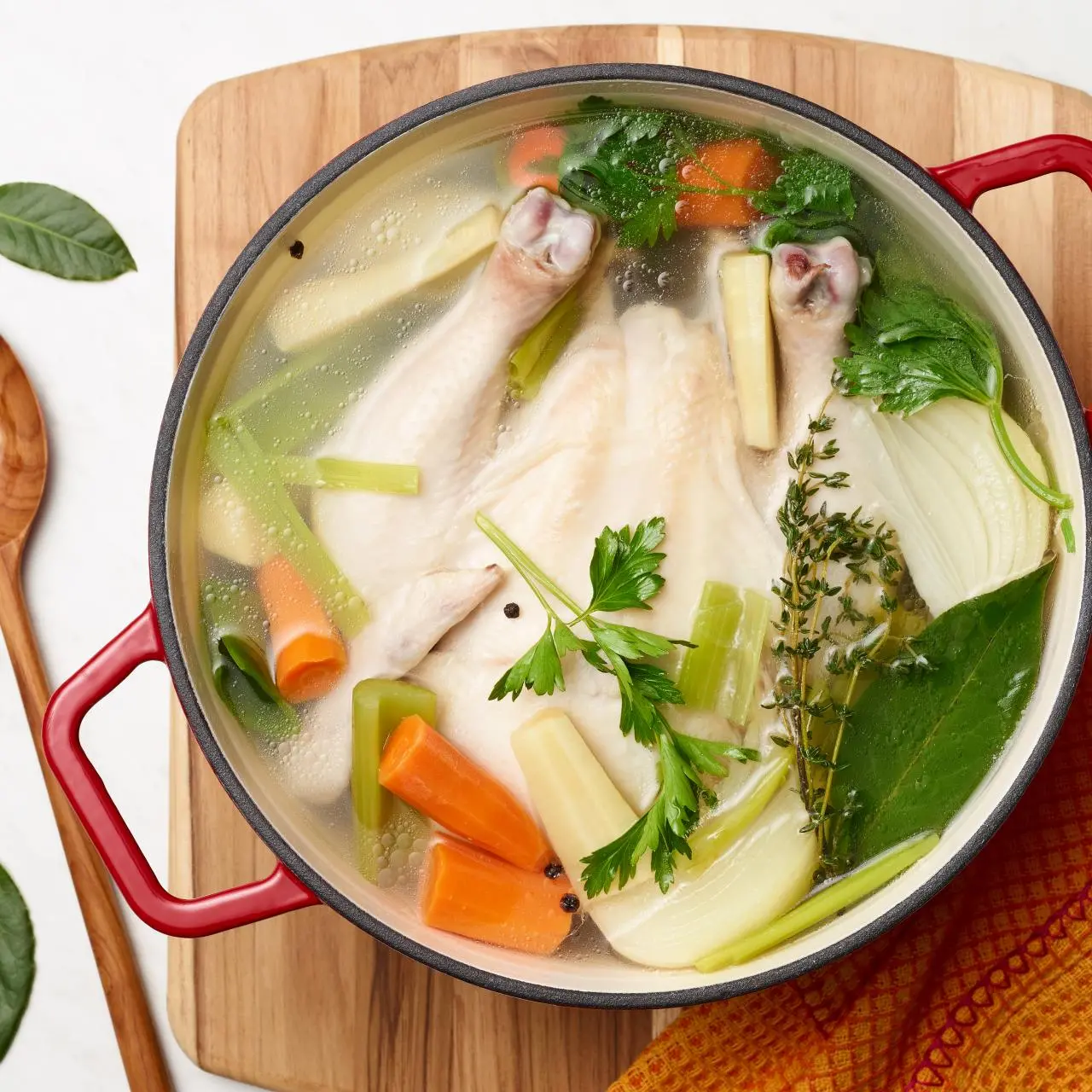How to Keep Chicken Broth Fresh for Longer Meal Prep Cycles
Wiki Article
The Ultimate Guide to Making and Delighting In Organic Bone Broths at Home
Bone brew has gained interest for its various health advantages and culinary versatility. Crafting natural bone broth at home allows people to regulate the high quality of components, ensuring a nourishing result. Understanding the option of bones, important flavoring components, and proper food preparation methods is vital. As the procedure unravels, one might ask yourself just how to elevate their broth beyond the basics and integrate it into daily dishes for enhanced taste and nutrition.Recognizing the Health And Wellness Advantages of Bone Brew
Although bone broth has actually been a staple in numerous cuisines for centuries, its wellness benefits have obtained significant interest in the last few years. Rich in collagen, amino acids, and minerals, bone broth is commonly promoted for its prospective to support joint health, enhance gut function, and enhance skin elasticity. The gelatin stemmed from prepared bones might assist food digestion and aid seal the gut lining, potentially reducing problems like dripping gut syndrome.Furthermore, the existence of nutrients such as glucosamine and chondroitin might add to lowered inflammation and pain alleviation in joints. Additionally, bone broth is hydrating and can function as a nutritious base for soups and stews. Numerous proponents also claim that it increases the immune system, many thanks to its mineral account. Generally, the rebirth of interest in bone broth is linked to its viewed ability to promote general wellness and support numerous physical functions.Choosing the Right Bones for Optimum Taste and Nutrition
What elements should one think about when choosing bones for broth prep work? The kind of bones used substantially influences both taste and dietary worth. First, it is important to select bones that include a mix of marrow bones, joint bones, and meaty bones. Marrow bones offer healthy and balanced fats and abundant tastes, while joint bones add collagen, boosting the brew's dietary profile.Additionally, sourcing bones from pasture-raised or grass-fed pets assurances better and even more nutrients, as these animals are normally much healthier. The freshness of the bones is also vital; selecting bones from neighborhood butchers or farmers' markets can guarantee perfect taste. Bone dimension matters as well; bigger bones release even more gelatin, leading to a richer broth. Ultimately, considering the kind of animal-- hen, beef, or fish-- can affect the final taste, enabling flexible brew options tailored to individual preferences.Crucial Components for a Flavorful Bone Broth

Quality Bone Option
The foundation of a savory bone brew lies in the careful choice of top notch bones. Sourcing natural, grass-fed or pasture-raised bones is essential, as these choices are more probable to be without damaging ingredients and supply premium nutrients. Selections such as hen, lamb, or beef bones each impart distinct flavors and health and wellness advantages. Bone types, including marrow bones, knuckle bones, and oxtails, add jelly and collagen, boosting the brew's appearance. Choosing bones with a mix of meat and connective cells can additionally add splendor and depth. Furthermore, picking bones with noticeable marrow assures a nutrient-dense broth, raising the overall high quality. Ultimately, spending time in high quality bone selection prepares for a scrumptious and nourishing broth.Aromatic Flavor Boosters
Selecting premium bones establishes the stage for a healthy and abundant bone brew, yet it is the enhancement of fragrant taste boosters that absolutely raises the meal. Active ingredients such as onions, garlic, and carrots not just impart sweetness but also add deepness to the broth. Fresh herbs like parsley, bay, and thyme leaves add a great smelling note, while spices such as black peppercorns and cloves introduce heat and complexity. Furthermore, incorporating a dash of apple cider vinegar can aid essence minerals from the bones, enhancing the broth. These taste enhancers develop an unified mix, transforming a simple broth into a tasty structure for sauces, soups, or stews, making it a functional element in any kind of culinary repertoire.Step-by-Step Guide to Making Bone Broth at Home
Producing bone broth at home can be a satisfying culinary venture that boosts both flavor and nourishment in numerous meals. To start, one must pick top notch bones, ideally from grass-fed or natural resources. Roasting the bones at 400 ° F for about thirty minutes can increase the flavor. Next off, transfer the baked bones to a huge pot or slow stove and cover them with cold water. Adding a splash of vinegar assists extract minerals from the bones.Include aromatic veggies like onions, carrots, and celery for added deepness, together with herbs and flavors as wanted. Bring the blend to a boil, after that reduce to a simmer. It is necessary to allow the brew simmer for a minimum of 12 hours, though much longer is more suitable for optimum splendor. Pressure the broth through a fine-mesh sieve and store it in impermeable containers, ready to elevate dishes with its nourishing significance.Tips for Perfecting Your Bone Broth Simmer
While simmering bone broth, maintaining the ideal temperature and timing is crucial for attaining a rich and delicious result. A gentle simmer, preferably in between 190 ° F and 210 ° F, helps extract maximum nutrients and flavors without steaming, which can make the brew cloudy. It is suggested to keep an eye on the pot closely, changing the warmth as essential to keep this simmer.Timing is likewise essential; a longer simmer, usually varying from 12 to two days, enables deeper taste removal and collagen release. For chicken bones, a 12 to 24-hour simmer is sufficient, while beef bones benefit from longer cooking times.Additionally, skimming any kind of foam or pollutants that increase to the surface throughout the initial few hours can enhance the broth's clarity and taste. Lastly, making sure the pot is covered throughout simmering aids to preserve wetness and increase the flavors, producing an extra enjoyable end item.Innovative Ways to Utilize Bone Broth in Your Cooking
Incorporating bone brew into different meals boosts both flavor and nutritional worth. Chefs and home cooks alike locate that making use of bone brew as a base for stews and soups enhances depth and splendor, transforming basic recipes right into hearty meals. It can likewise be utilized in risottos, where the broth replaces water, allowing the grains to absorb its full-flavored essence.Additionally, bone brew acts as an exceptional cooking fluid for grains like quinoa or rice, infusing them with nutrients and flavor. For an included spin, it can be utilized in braising meats, causing tender, tasty results. Even sauces gain from a splash of bone brew, enhancing their taste profile.Moreover, bone brew can be included into shakes for an unexpected health and wellness increase, supplying healthy protein and nutrients without endangering taste. These creative applications showcase the convenience of bone brew in daily food preparation, making it an indispensable cooking area staple.Saving and Protecting Your Self-made Bone Broth
Correct storage and preservation of homemade bone brew is essential for maintaining its flavor and dietary benefits. Freezing methods and refrigeration ideal methods play a vital function in expanding the brew's life span. Comprehending these methods can assist assure that the brew remains risk-free and delicious for future usage.

Icing Up Techniques Described
Freezing strategies are crucial for properly keeping and protecting homemade bone broth, ensuring its abundant flavors and nutrients continue to be intact for future usage. To freeze bone broth, it is recommended to allow it awesome completely prior to transferring it to storage containers. Glass jars, silicone molds, or durable freezer bags are suitable alternatives. When utilizing containers, leave room on top for growth during freezing. Portioning the broth right into smaller sized quantities permits very easy thawing and minimizes waste. Label containers with the date and contents for simple identification. For peak quality, eat the icy brew within three to 6 months - Chicken Broth. Thawing can be done in the refrigerator or by using a microwave, guaranteeing that the broth is warmed completely before usageRefrigeration Best Practices
While many focus on cold as a method of preservation, refrigeration likewise plays an important role in saving homemade bone broth properly. Once cooled down, bone brew should be Benefits Of Bone Broth moved to airtight containers, assuring minimal air direct exposure to protect against spoilage. It is advisable to refrigerate broth within 2 hours of cooking to maintain its high quality. Usually, homemade bone broth can be saved in the fridge for approximately 5 days. Identifying containers with dates can assist track freshness. For peak taste and security, brew ought to be reheated to a moving boil before intake. If longer storage space is required, cold remains an exceptional choice, however appropriate refrigeration methods assure that bone brew stays tasty and healthy for temporary use.Regularly Asked Questions
Can I Use Frozen Bones for Making Bone Brew?
The inquiry of making use of frozen bones for bone brew emerges frequently (Bone Broth Delivery). Specialists concur that icy bones can be made use of properly, but they ought to be thawed prior to cooking to ensure perfect flavor and nutrient removalHow Much Time Can I Store Homemade Bone Broth?
:max_bytes(150000):strip_icc()/7149475-4358977a70b6445dbc1fb2aea21db358.jpg)
Is It Safe to Reheat Bone Broth Multiple Times?
Reheating bone brew multiple times can pose safety and security problems - Beef Broth. Each reheating cycle increases the threat of microbial growth. It is advisable to reheat only when and keep any leftovers quickly to guarantee security and qualityCan I Add Veggies to the Broth for Taste?
Including veggies to brew improves flavor and dietary value. Common choices include carrots, onions, and celery. The veggies instill their essence into the brew, producing a richer and a lot more full-flavored end product.What's the Ideal Way to Defrost Icy Bone Brew?
To thaw frozen bone broth, one can place it in the fridge overnight, use a microwave on low warm, or submerge the sealed container in warm water, ensuring also thawing without endangering flavor or nutrients. It is essential to choose bones that consist of a mix of marrow bones, joint bones, and weighty bones. Marrow bones supply abundant flavors and healthy fats, while joint bones add collagen, boosting the brew's nutritional profile.Additionally, sourcing bones from grass-fed or pasture-raised animals warranties greater high quality and even more nutrients, as these animals are typically much healthier. Bone types, including marrow bones, knuckle bones, and oxtails, add jelly and collagen, enhancing the broth's structure. Choosing premium bones sets the phase for a abundant and nourishing bone broth, yet it is the addition of aromatic flavor boosters that genuinely elevates the meal. Also sauces profit from a dash of bone broth, enriching their taste profile.Moreover, bone broth can be included into healthy smoothies for an unforeseen wellness boost, supplying healthy protein and nutrients without compromising taste.Report this wiki page